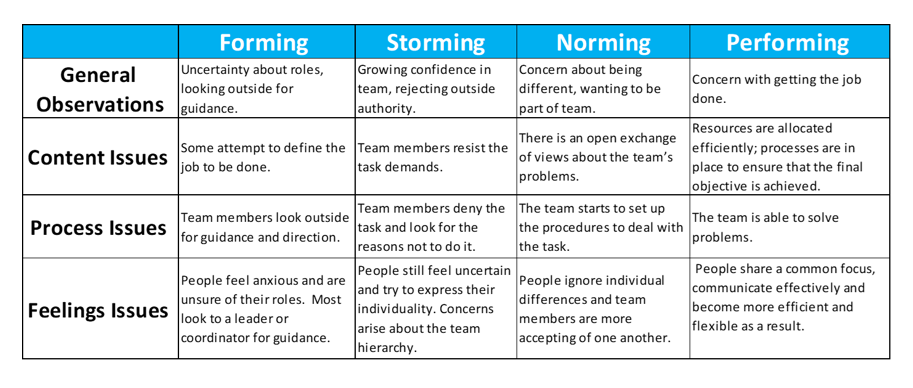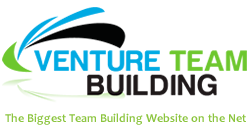Psychologist, Bruce Tuckman first came up with the Stages of Team Development model in 1965. The model explains how a team develops over time, which consists of 4 key stages, “forming, storming, norming and performing”. An additional stage was later added in 1977, this stage is “adjourning”, which is used to describe the break-up of a team following project completion. Tuckman believes that all phases are both essential and inevitable for team growth.
Bruce Tuckman’s forming, storming, norming, and performing model describes these stages and is a helpful tool when working with new teams. Once you understand this model, you can help your new team become effective more quickly.

A team’s internal processes usually change over time. Like individuals, teams develop their skills, the more they use them. Team functioning generally improves after the team has been together for a while and experienced the concept of Forming, Storming, Norming and Performing
When faced with a new team it is essential that they build rapport with one another and develop trust. When starting out, you cannot expect them to click and everything to fall into place and get optimum performance. Forming a team takes time, and team members often go through different stages of development before finally uniting as a team and achieving success.
Tuckman theorizes that these phases are all necessary and inevitable in order for the team to grow, face up to challenges, tackle problems, find solutions, plan work, and deliver results.
Tuckman’s model focuses on the way in which a team tackles a task from the initial formation of the team through to the completion of the project or end goal.
In this article, I’ll be looking at how you can use this model to build a highly productive and successful working team.
Forming Stage
This is the stage when your group come together for the first time. At this important stage of the team development process, the focus during the forming stage should be to build relationships within the team and clarify the mission or end result.
The forming stage signifies a time when the group is just starting to come together and is characterized by both anxiety and uncertainty. In newly formed teams, relationships often are guarded, cautious and noncommittal.
Group members tend to act independently and are cautious with their behaviour, which is driven by the want to be accepted by all members of the group. Any conflict, controversy or personal opinions are often avoided, as team members form impressions of each other and gain an understanding of what the group will do together.
Understanding leadership roles and getting acquainted with other team members facilitate faster team development.
Typical outcomes of the forming stage include:
- understanding the team’s purpose (end result)
- determining how the team will be organised
- delegating responsibilities and accountability
- discussion of milestones or short-term goals
- outlining team rules including future meeting dates
- discussion of resources available
Storming Stage
During this second stage, team members feel more comfortable expressing opinions and you’ll see some internal conflict emerge within the group.
Storming often starts when there is a conflict between team members’ natural working styles or a disagreement of opinion or values. Everyone works differently and has their own style, but this can sometimes cause personalities to clash and affect how a team works. During the conflict, team members will become increasingly frustrated and will lose motivation for the task or project. Although conflict resolution is often the goal of work teams during the storming stage, conflict management is generally what is achieved.
Storming behaviours include:
- Challenging authority
- Resisting opinions and improvements suggested by others
- Negative mindset and attitude about the team and the project’s success
- Arguments among team members even when they agree
- External factors and company culture
- Competition, support and forming of smaller teams
- Questioning the team’s goal and resistance to taking on tasks
This phase can become extremely destructive and will lower motivation if allowed by the team leader to get out of control. Some teams will never develop past this stage, that said, conflict and disagreements within the team can also make a team stronger, more versatile, and able to work more effectively as a unit. The storming stage is necessary for the growth of the team. This phase can sometimes take up to three or four meetings before transitioning into the norming phase.
Norming Stage
Once a group receives the clarity and support that it so desperately needs, it can move on to the third stage of team development, known as the norming stage.
In the norming stage, team members become increasingly positive about the team as a whole, the other members as individuals and what the team is doing. Morale is high as group members actively acknowledge each other’s talents, skills and experience. Team relationships are better than ever, they respect and trust each other and the group remains focused on the purpose and end result. Members become more flexible and interdependent on each other and communication improves.
Norming behaviours include:
- Ability to offer and accept constructive criticism.
- Open communication and discussions independently.
- An attempt to avoid conflict whenever possible for the greater good of the team.
- Better working relationships, supporting and trusting each other.
- Improved team ethos, cohesion and spirit.
- Establishing and maintaining team rules and expectations.
If the norming stage can be reached, it is an exciting time for all involved. This is a time when decisions can be made and implemented, new ideas developed and turned into reality, risks can be taken and any failure can be seen as just another step on the pathway to succeeding.
At this stage, responsibilities and working relationships are now established, allowing individuals to focus on demonstrating the talents that got them into the team in the first place. Team leaders can step back and allow individual members to work autonomously and take greater responsibility.
Nine times out of ten, if a team can reach the norming stage they are probably close to succeeding and reaching their goal.
Performing stage
At this stage, team members usually come to trust and accept each other. Individuals are now competent, autonomous and able to handle the decision-making process without the need for the leader’s supervision.
Leadership within the team is flexible and may shift among members in terms of who is most capable of solving a particular problem. The team is more strategically aware; the team knows clearly the purpose and why they are doing what they’re doing. The team has a shared vision and is able to work independently and with no interference or participation from the leader.
Teams that perform at a high level are able to function as a unit and find effective working strategies without inappropriate conflict.
Performing behaviours include:
- Individuals can clearly identify their roles within the team and appreciate other team member’s strengths and weaknesses.
- Members have the ability to prevent or continue working through issues that arise.
- Everyone demonstrates a great working relationship and support for each other.
- Members direct their energies towards the attainment of goals.
- The team have adopted procedures for making decisions, including how to share leadership responsibilities and work delegation.
- Individuals have a sense of freedom and a sense of belonging.
Sometimes at this stage disagreements may occur, but are now resolved within the team positively, and any required changes to processes and structure are made by the team.
The team is able to work towards achieving the goal, and also to attend to relationship, style and process issues along the way. Now team leaders can finally move into a coaching role and aid the development of team members, whilst having trust in their team to perform and succeed.
Adjourning stage
Tuckman’s fifth stage of development, ‘Adjourning’ is the break-up of the team, when hopefully the task or project is completed successfully.
Many teams will reach this stage eventually. For example, project teams exist for a short fixed time period, and even permanent teams may be disbanded through organisational restructuring. This entails the termination of roles, the completion of tasks and the reduction of dependency. Following the completion of the task, everyone can move on to new projects, feeling positive about what’s been achieved.
The process can also be stressful for individuals, particularly when the dissolution is unplanned. Towards the end of the natural life of the team, people may start to worry about disbanding and the project’s conclusion. Team members who like routine, or who have developed close working relationships with other team members, may find this stage difficult, especially if their own future now looks uncertain.
The Team Leader Role
The responsibility of the team leader is to provide direction, identify working strategies and processes and delegate responsibility and accountability within the team. The leader must have a clear understanding of the project and project scope and be prepared to answer lots of questions about the team’s purpose, objectives and external expectations.
The most valuable part a team leader can play is to recognize which stage of development the team is performing at and provide the appropriate support to ensure improved team development and eventual project success. Once established, use strategies that will move your team through to the next stage in the team formation process. By following this simple process, you will quickly have a high-performing team.
Helping a Forming Team
The forming stage of development is best done as a project introductory workshop. At this stage, the project or task should be clearly communicated without overwhelming team members. You should keep it simple for the first meeting and just lay the foundations. You should also allocate enough time for everyone to get to know each other by using appropriate icebreaker activities and team challenges.
After, clearly communicating expectations, roles and responsibilities – a good way of doing this is by asking team members what they feel they can contribute to the project and having them pick their own responsibilities.
Helping a Storming Team
The leader needs to focus the team on its short-term targets and end goals to help them avoid becoming distracted by relationship and emotional issues. Storming can be reduced by clarifying work goals and individual roles and objectives. When people know what individual success means, they become more focused.
Explain the “forming, storming, norming, and performing” model, so team members understand why problems occur, and the likely improvement in the future.
Leaders should aim to move into more of a coaching role, which is less likely to create resentment and aids the development of self-reliance within the team. You should also look to coach team members in conflict resolution skills when necessary. This will hopefully accelerate the team into the norming phase.
Try some of the following if you feel your team development isn’t progressing:
Normalise conflict: Explain that this is a natural phase of the group formation process and discuss Tuckman’s, ‘Forming, storming, norming, performing’ model.
Be inclusive: Make all members feel included and create an open forum for team discussion, inviting all views and opinions. Comment on how a variety of ideas and opinions help foster creativity and innovation.
Make sure everyone is heard: Monitor and facilitate any heated discussions and help team members understand each other.
Support all group members: This is especially important for those who feel a little insecure. Talk to all members of your team and even have 1-on-1 informal chats about development and allow them to share their concerns and opinions with you.
Remain positive: For the success of any task, you need buy-in. The team leader will be directing the project and will need to motivate and inspire others by sharing their outlook and vision.
Don’t rush Team Development: Slow and steady wins the race and working through the storming stage can take several meetings. Remain positive at all times.
Helping a Norming Team
Facilitation is best used when managing a norming team. By using facilitating, you provide an opportunity for team members to work autonomously and take on more responsibility, making their own decisions. When you do this, it is important to only interfere if the situation absolutely requires it.
The leader should ensure that the purpose of the task or project remains clear and challenge the team should they become complacent, to try and accelerate them into the performing phase.
Try to use questions to get team members to think about the task strategically and form their own ideas on the best solutions. Refrain where possible from telling others how to do something as this doesn’t get the best long-term results and you will end up regressing to the storming stage. Allow independence and see what the team produce (they might surprise you).
Helping a Performing Team
Team Leaders should delegate and oversee a performing team, they should resist the urge to instruct or assist when not required. Their focus should transition from people management to more work-related tasks. They must continue to provide ongoing support and motivation and be invaluable as a source of advice when needed.
The leader should recognise the contribution of the team and give credit when providing reports to others. If anyone is left feeling that their contribution is not being recognised, the resentment may be carried through to the next project and storming will be more difficult to overcome.
Helping an Adjourning Team
Team leaders and members should be sensitive to handling these endings respectfully and empathetically. The best method of closing a project group is to set aside time to allow for a proper debrief and a celebration of their success.
This is an opportunity to thank the project team and recognise both team and individual achievements. Allow an opportunity to reflect on performance and discuss any improvements for future project management activities. After this, report any discoveries and achievements to key stakeholders outside of the team.
Remember, as a team leader you may have to work with this group of individuals again and it will be much easier if people view your working relationship and past experiences positively.
This website teaches you how to deliver and provide successful team-building experiences for your groups. Check out our free team building activities section and don’t forget to subscribe to our newsletter to receive the latest website updates in your inbox.
Reference:
Tuckman, B. W. (1965). Development sequence in small groups.
Tuckman, B.W. & Jensen, M.A.C. (1977) Stages of small group development revisited. Group and Organizational Studies




You’re so awesome! I do not suppose I’ve truly read something like this before.
So nice to discover somebody with a few unique thoughts on this issue.
Seriously.. thanks for starting this up. This
site is something that is required on the web, someone with a little
originality!
Glad you liked it.
Well articulated
Thanks!
Superb blog by the way!
Thanks.
Thanks a lot for sharing this amazing article, it’s very true that building a team needs to go through some really important stages that are necessary to ensure that it is very efficient and that it meets the requirements for which it has been formed. This article will help people know how to build a strong team.
I hope this helps readers understand the process of building a team a little better. Glad you found it useful.
Thank you for sharing these fascinating factors of teamwork. People dynamics have always fascinated me. It has always been a problem between my co-workers when they do not get along and the work is stalled. I am most often familiar with the general issues they are facing.
The stages of team building make total sense. This is why I see the conflict right off at the second stage. As a manager myself, I think storming is the hardest stage. Thanks for the link for the team building activity, will check it out!
Thanks – We have 100’s of team building activities on our site to aid individuals looking to use at work, home, school, church, or wherever they want to strengthen a team.
Wow, I have been greatly impressed by your website and I think that everything that I AM learning here is some great added blessing to me. I’m not going to put this aside. Want to read all this again and digest it and also show this to my proposed team so we can know what we can do to ensure that we are better enforced for what we are about to go into.
Jay – Glad you found this useful.
We have a lot of resources on our site that can help you learn more about teams, access our library of over 100 team building activities, or check out our virtual team building activities.
Just like you have pointed out here very well and quite clearly, the role of the team leader is massive and requires a lot more from him than meets the eye. To actually get a team working, the earlier stages require a lot of work that must not be overlooked in the long term. Thank you so much for sharing here and I hope to see more in the long term.
Yes Kimberly Team Leaders play an important part in a team and once we understand that role hopefully that helps us to be better team members as well.
Thank you so much for sharing with us a beautiful and informative article. The content about Forming, Storming, Norming, and Performing is truly remarkable and you have presented this topic so well in your article. I have learned a lot by reading your article and gained a lot of knowledge about it. Of the points mentioned in your article, I like the Norming stage. To build a successful team building, you must hit all the stages as mentioned in your article.
I have really enjoyed your article so I definitely want to include in my social media planet this article so that everyone knows what is needed in teamwork and works accordingly.
Thanks glad you enjoyed it.
This is absolutely a great way to build a team. These stages are important components of forming a team. I like how the stages are set up to make a functional team. That said, team building makes a strong foundation of any venture or business. I have learned something here and I’ve copied the model chart for quick understanding if you don’t mind. Thanks for the helpful article.
Not a problem – Glad you found it useful.